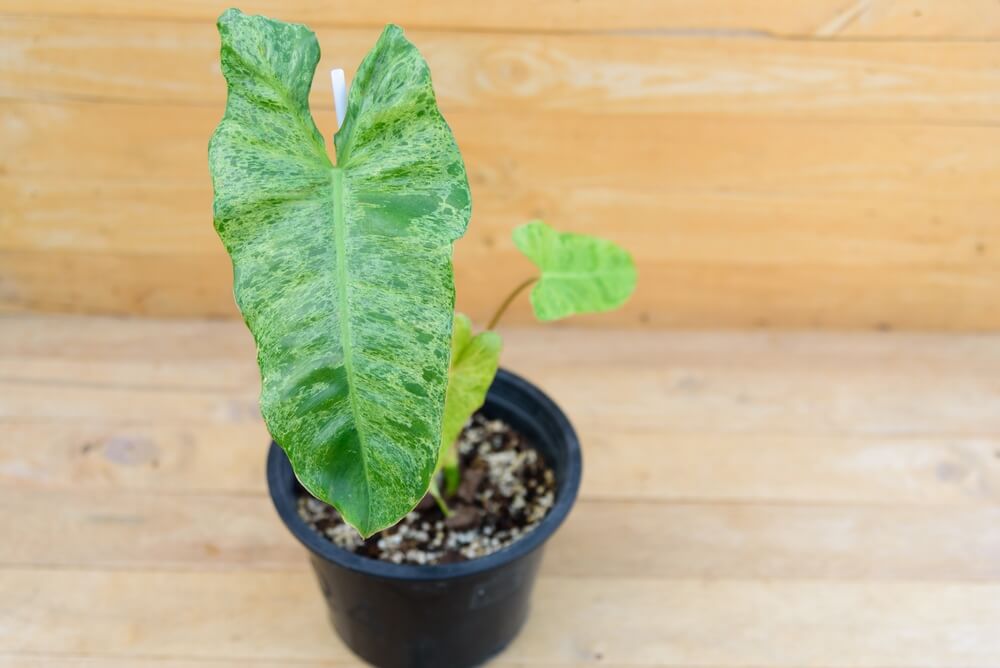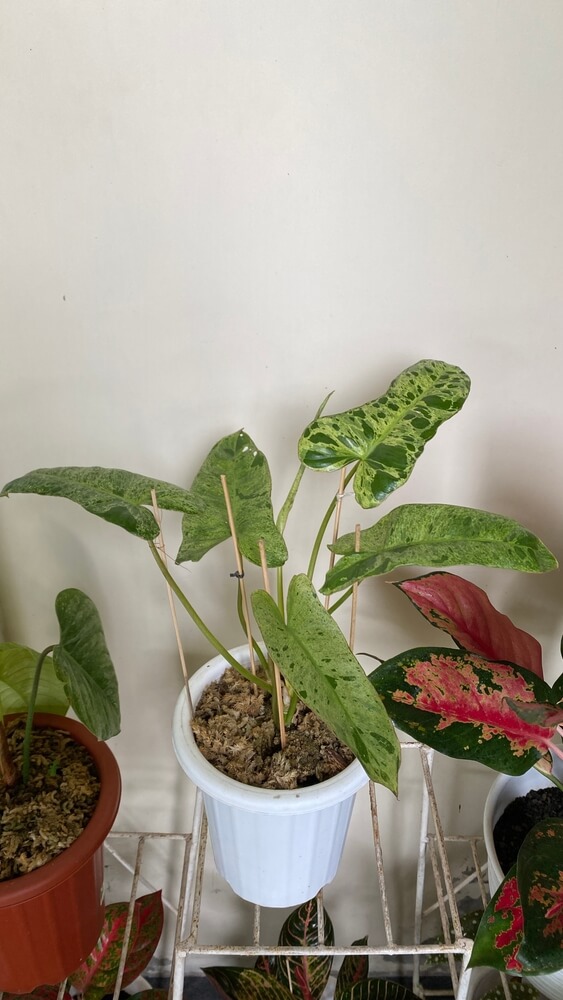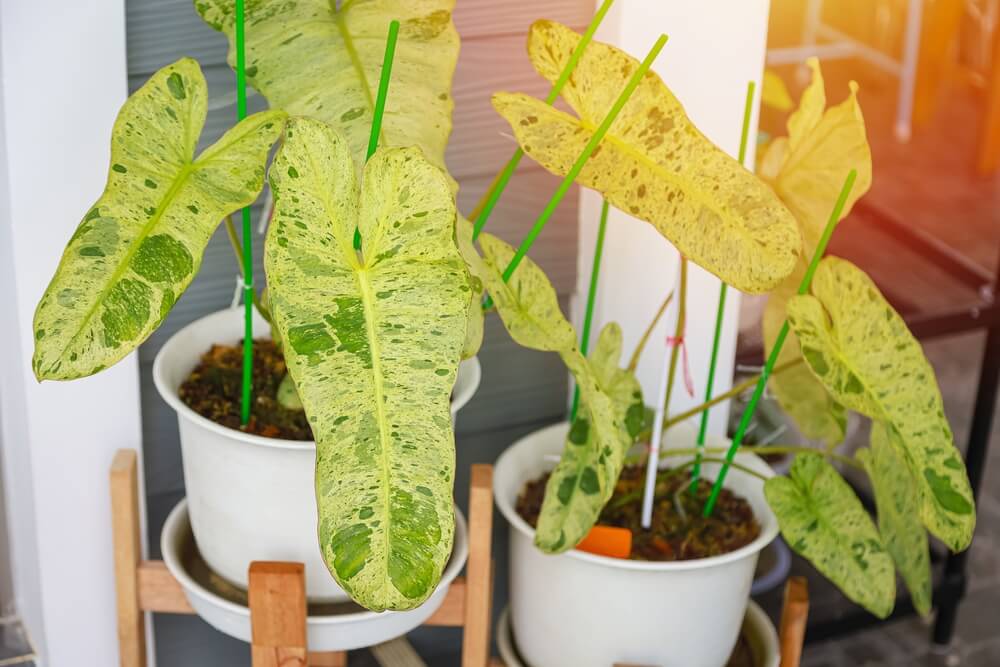While the philodendron Paraiso Verde is a rare tropical delight, it isn’t as difficult to care for as people assume. This plant originates in the West Indies and America with stunning, variegated heart-shaped leaves. Its elongated leaves grow as long as 10 inches on short stems. It is a hearty plant that, if cared for properly, provides years of enjoyment for the plant owner and visitors!
Caring for the philodendron Paraiso Verde appropriately means you have a unique and highly sought-after addition to your plant collection. As a plant parent, I understand the need for accurate information on how to best care for each particular type of plant. There are variations in light, water, soil, fertilization, pest control, toxicity to children or pets, humidity, temperature, and repotting needs.
In This Article
How Much Sunlight Does a Philodendron Paraiso Verde Need?
As a native of tropical environments, the philodendron Paraiso Verde thrives in a warm, humid atmosphere. To achieve a more optimum growing situation, try the following:
- Place your plant in an area that receives indirect sunlight, preferably an east or south-facing window. If there is too much light, add a sheer curtain over the window to diffuse the light.
- I am putting the Paraiso Verde in a darker space, which results in slow growth and yellowing leaves.
- To encourage more variegation, move your philodendron Paraiso Verde to early morning direct sunlight only. It is a delicate balance, as too much full exposure to the sun may burn the leaves.
- Humidity should be at 60-70%. To ensure this happens, try using an indoor humidifier. It is essential to keep the humidifier clean to avoid a fungus growing on your plants and use distilled water.
- Another way to develop humidity is through water, like a pond or water feature nearby. Also, the use of a pebble tray creates humidity. Simply fill a tray with pebbles and cover them with water. Place the plant on top of the tray and as the water evaporates, it results in humidity around the plant.
- The temperature should not be below 64 degrees or above 98 degrees to keep this plant growing heartily.
What Are the Watering Requirements for a Philodendron Paraiso Verde?
Duplicating your philodendron Paraiso Verde’s natural conditions is the best way to help it thrive. These plants enjoy it when the soil becomes dry before receiving more water. If you overwater, your plant will be root rotted. To ensure this happens, do the following.
- Check your plant’s soil using a moisture meter or push your finger into the ground at least 1.5 inches. If you feel any moisture, your plant doesn’t need watering.
- Use trapped rainwater or filtered water rather than tap water. Tap water contains sediment and chemicals that harm delicate growing things.
- To water your Paraiso Verde, remove it from the saucer and place it in the sink. Water until the liquid begins to escape through the hole in the bottom. Allow the flow to stop before placing the plant back into its saucer.
- Watering your plant in its saucer isn’t advised as it can cause a backlog of water in the soil.
Determining the Right Soil Conditions for Your Philodendron Paraiso Verde
Soil conditions are also a vital part of your plant’s health. Philodendron Paraiso Verde does best in these circumstances:
- In light, well-draining soil
- With added peat moss, coconut fiber, vermiculite, charcoal, or perlite to prevent the soil from drying out.
- Keep the soil at a 5.0-6.0 pH level to avoid disease or other issues.
Do I Need to Fertilize my Philodendron Paraiso Verde?
Philodendron Paraiso Verde doesn’t need a lot of fertilizing. Just like people, a balanced diet is a key to health. Choose a fertilizer to apply only during the growing season. The mixture should include balanced potassium, phosphorus, and nitrogen ratio. Natural methods include coffee grounds mixed with egg shells, banana peel, fish emulsion, and worm castings. An overfertilized plant develops yellow leaves, so keep an eye out and cut back on fertilizer if necessary.
What if my Philodendron Paraiso Verde is Infested with Pests?
Like most plants, the Philodendron Paraiso Verde is prone to infestation by pests. Typical culprits include scales, mealy bugs, aphids, and spider mites. These bugs generally look for weaker plants as they must be able to pierce the waxy surface of the leaf. The critters will look elsewhere for food if this protective layer is thick. Since this is the case, preventative care is the answer to pest control.
Although a healthy plant isn’t as susceptible to insects, here are some answers to help with encroachment:
- Inspect your plant every time you water it. If you see bugs, use a soft cloth soaked in anti-insecticidal soap and water to wipe them off. This is often enough.
- Wiping down your Philodendron Paraiso Verde with Neem oil also helps to ward off any infestation.
- If these solutions don’t work, use an insecticide safe for plants.
- Separate infested plants from others to avoid passing on the problem.
Diseases Prevalent in the Philodendron Paraiso Verde
As a loving plant owner, you might wonder what diseases affect the Philodendron Paraiso Verde. Most of the issues this type of plant experiences involve over or under-watering. Be on the lookout for the following leaf indications that could happen:
- Wilting: caused by lack of water or humidity – check the soil with a finger test, and if it is moist, increase the humidity.
- Brown tips: a sign of underwatering – tips will remain brown, but the damage is minimized.
- Curling: indicates over-fertilizing, low humidity, or underwatering. Adjust as necessary.
- Brown soggy: Root rot is a severe condition. Immediately remove the plant from its pot and place it in the sun to dry out. Once it is dried, cut off any brown areas and repot in dry soil in a well-draining pot. Don’t water for a few days.
- Black or brown spots: A fungal infection is present due to wet conditions. Use a horticultural fungicide and avoid getting the leaves wet when you water.
Do I Need to Repot My Philodendron Paraiso Verde?
Repotting should occur in early spring and when roots are beginning to creep through the pot’s drainage holes. Select a pot at least 2 inches larger than the current one. Fill the bottom of the pot with a bowl-shaped layer of well-aerated soil. Place the roots and plant gently in the area and cover with new soil. Water and watch for any signs of stress over the next few days.
How Do You Make Paraiso Verde More Variegated?
Indirect sunlight increases the amount of variegation on the plant. Indoor living plants are inclined to be more solid colored, so placing the plant near a window or on a shaded porch will increase the variegation.
Is Philodendron Paraiso Verde Toxic?
Philodendron Paraiso Verde, like all philodendrons, contains a toxic substance called calcium oxalate crystal. If this is ingested, it is poisonous to people and pets. As it is a climbing plant, hanging your Paraiso Verde is a great option to protect others from accidental ingestion. Remember cats are climbers too (and sometimes kids are), so just because your plant is high up doesn’t mean your feline can’t reach it!
Is Philodendron Paraiso Verde Rare?
The Philodendron Paraiso Verde is a rare find and costly to purchase. If you are lucky enough to obtain one, ensure that you take good care of it! The good news is the plant does propagate easily and grows quickly. Its rich, elongated leaves like to climb, so provide a safe, comfortable place for this to happen. In its natural environment, the Philodendron Paraiso Verde climbs tree trunks. Cultivating climbing is easily accomplished with a moss pole, lattice, trellis, cage, fence, or other sturdy upright items. This will only enhance the beauty of your Paraiso Verde. Enjoy!
Philodendron Paraiso Verde Reverted
If you notice your Philodendron Paraiso Verde reverting, there are a few things you can do to help it return to its original coloration. First, check the light levels in its environment and make sure it is getting enough bright, indirect sunlight. If it is not, try moving it to a brighter spot. If that doesn’t work, you can try giving it a light misting with water every few days. Finally, if all else fails, you can take stem cuttings from the plant and propagate new plants that will be true to their original coloration. With a little patience and care, you should be able to get your Philodendron Paraiso Verde back to its beautiful green self in no time!
What to Do with a Mature Philodendron Paraiso Verde?
When your Philodendron Paraiso Verde is mature, it will require less frequent watering than when it was a juvenile. Allow the top 2-3 inches of soil to dry out before watering again. During the winter months, you can reduce watering even further, only giving your plant a drink every 2-3 weeks.
Fertilize your Philodendron Paraiso Verde monthly with a half-strength balanced fertilizer during the growing season. You can reduce fertilization to once every other month during the winter.
As far as light goes, your Philodendron Paraiso Verde will do best in bright, indirect sunlight. It can tolerate some direct sun, but too much will scorch its leaves.
Finally, make sure your Philodendron Paraiso Verde has good drainage. Water that sits in the soil can lead to root rot, so be sure to use a pot with drainage holes and never let your plant sit in water.
Philodendron Paraiso Verde Price
If you’re looking for a Philodendron Paraiso Verde, you can expect to pay anywhere from $20-$40. Keep in mind that the price will vary depending on the size and condition of the plant.
Philodendron Paraiso Verde For Sale
There are a number of places you can buy this plant online, including:
- https://www.amazon.com/gp/product/B07BLNFNJ1?ref=ppx_yo_dt_b_asin_title_o00_s00
- https://www.etsy.com/listing/659085784/philodendron-paraiso-verde-aroid?gps-location=&ref=shop_home_active_21
- https://www.houzz.com/products/philodendron-paraiso-verde-plant-shipped-in-4-inch-pot–prvw-vr~118896481
Frequently Asked Questions
Yes, this plant is quite rare and difficult to find. It is native to South America and is not often seen in cultivation.
This plant is expensive because it is rare and difficult to find. It is also a slow-growing plant, which makes it even more desirable to collectors.
No, this plant does not revert back to its original form. It is a stable cultivar that will maintain its variegated leaves and compact growth habit.
There is no guaranteed way to increase the amount of variegation on this plant. However, some growers have had success by growing it in very bright light. This will cause the leaves to become more intensely colored.
If the leaves of your plant start to lose their variegation, it is likely due to too little light. Move the plant to a brighter location and the variegation should start to come back.
This plant is a hybrid of Philodendron hederaceum and Philodendron erubescens. It was created by growers in Florida and is not found in the wild.
This plant can be by stem cuttings. Take a cutting from the main stem, including a few leaves, and place it in water or moist soil. It should root within a few weeks.
Yes, philodendron Paraiso Verde is a very rare plant. It is native to South America and only found in a few locations. This makes it difficult to find and collect.
Philodendron Paraiso Verde is expensive because it is so rare. There are only a limited number of plants available and they are not easy to find.
No, philodendron Paraiso Verde is not a fast grower. It takes several years for the plant to reach its full size.
Additional Sources & Resources
There are a ton of great video overviews of how to care for a Philodendron Paraiso Verde. Here is a terrific overview of care and propigation:
Another live video with footage of the plant as well as a series of tips:
And we’ve also collected a variety of academic resources about the plant if you want to learn more:
1. “A new Philodendron (Araceae) species from the Atlantic Forest of Brazil.” Rodrigues, Fábio de Castro, et al. Kew Bulletin 67.3 (2012): 523-531.
http://dx.doi.org/10.1007/s12225-012-9370-4
2. Systematics and Evolution of Philodendron Subgenus Meconostigma (Araceae) Based on Morphology and Molecular Data. Sánchez-del Pino, Isabel, et al. International Journal of Plant Sciences 169.9 (2008): 1063-1084.
https://www.journals.uchicago.edu/doi/10.1086/593004
3. “A revision of Philodendron subgenus Philodendron (Araceae) for Mexico and Central America.” Mayo, Sarah J., et al. Botanical Journal of the Linnean Society 181.1 (2016): 1-27.
https://onlinelibrary.wiley.com/doi/full/10.1111/boj.12382
4.” Migration patterns and genetic diversity in the neotropical liana Philodendron bipinnatifidum.” Silva, Fábio de Sousa, et al. Plant Biology 18.6 (2016): 1237-1246.
https://onlinelibrary.wiley.com/doi/full/10.1111/plb.12447
5. “The liana Philodendron bipinnatifidum (Araceae) in Brazil: a review of its taxonomy, distribution and ecology.” Ferreira, Erika Dutra, et al. Acta Botanica Brasilica 27.4 (2013): 785-794.
http://www.scielo.br/scielo.php?script=sci_arttext&pid=S0102-33062013000400785&lng=en&nrm=iso&tlng=en
6.” Epiphytic Philodendron species (Araceae) in a lowland rainforest in Central Amazonia.” Pabst, Günther F. J., and Irmgard Pabst. Brittonia 40.1 (1988): 87-106.
https://www.jstor.org/stable/2808129?seq=1
7.” Soil type affects the distribution of lianas and trees in an Amazonian rain forest.” Martins, Edna Dias, et al. Forest Ecology and Management 311 (2014): 80-88.
http://www.sciencedirect.com/science/article/pii/S0378112714000285
8. “Functional diversity of lianas and trees in an Amazonian rainforest.” Martins, Edna Dias, et al. Forest Ecology and Management 299 (2014): 1-9.
http://www.sciencedirect.com/science/article/pii/S0378112714000573
9. “The need for a species concept in philodendron taxonomy (Araceae).” Mayo, Sarah J., et al. Botanical Journal of the Linnean Society 181.1 (2016): 28-41.
https://onlinelibrary.wiley.com/doi/full/10.1111/boj.12383
10.” Genetic diversity and structure of natural populations of the neotropical liana Philodendron bipinnatifidum.” Silva, Fábio de Sousa, et al. Plant Biology 18.6 (2016): 1247-1257.
https://onlinelibrary.wiley.com/doi/full/10.1111/plb.12448
11.” Spatial and temporal variation in liana abundance across Amazonian forests.” Pfeifer, Marion, et al. Ecology 93.9 (2012): 1961-1971.
http://dx.doi.org/10.1890/11-1632.1



